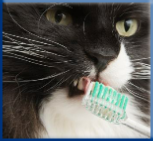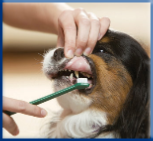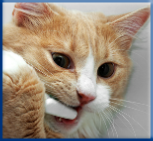Dental prophylaxis is a treatment for periodontal disease as well as for disease prevention. We want to keep your pet’s teeth and mouth as healthy as possible, thus each prophylaxis includes the following:
- A general exam before anesthesia, including evaluation of the bite, pre-anesthetic bloodwork (if requested), and the identification of abnormal wear patterns, gum infection, tumors, etc. We strongly recommend the pre-anesthetic bloodwork which helps us to better evaluate your pet’s current health status and to ensure safe anesthesia.
- An oral exam under anesthesia.
- Removal of plaque and tartar deposits (scaling) above and below the gum-line using special hand instruments and electronic devices.This is performed under general anesthesia, providing immobilization of the pet and pain control. Intubation allows for the administration of anesthesia and prevents the pet from inhaling bacteria-laden particles as they are removed from the teeth.
- Any pockets below the gum-line are rinsed to eliminate debris and prevent abscesses. They may also be treated with a long acting doxycycline polymer (long acting antibiotic).
- Tooth polishing with fluoride. Polishing provides a smooth surface to which plaque and tartar do not as easily adhere.
- Digital radiographs as recommended.
- Dental charting for the medical record.
- Preventive therapy as recommended.
Periodontal disease is an oral inflammatory disease, or infection, of the tissues that support the teeth (periodontium) and the gums (gingiva). The disease destroys the tissues, causing the gums to retract, resulting in roots that are bared and the formation of pockets beneath the gums. In advanced cases, abscesses can form in the pockets. The infection causes progressive bone loss around the teeth, loosening of the teeth, and eventual tooth loss.
Periodontal disease is caused by the accumulation of plaque and tartar (calculus) on the teeth and supporting tissue. Plaque develops when bacteria accumulate and combine with saliva to form a film that coats the teeth and gums. The disease includes both gingivitis and periodontitis and may be transmitted by the circulatory system to other areas of the body, such as the heart, liver, lungs, and kidneys, where it can cause life-threatening damage.
Inflammation of the gums (gingiva), without loss of supporting structure(s) of the teeth, which may or may not be visible to the eye.
A destructive process involving the loss of supporting structures of the teeth.
Periodontal disease is one of the most common, most diagnosed, most often recognized health problems among pets. More than 80% of dogs and 70% of cats develop the disease by the age of three. Poor oral hygiene, tooth alignment and pressure, systemic health, breed, and age all contribute to periodontal disease.
We recommend Royal Canin Veterinary Dental Diet. It contains a unique blend of plaque-reducing nutrients and a sequestering agent to reduce tarter. The mechanical action of the kibble reduces plaque, and it is available in two kibble sizes specifically designed for adult dogs weighing more than or less than 25 pounds.
Pets can get cavities, but they are relatively rare. Cats do sometimes suffer from painful lesions that are referred to as “cat cavities.”
Your pet will need his teeth cleaned anytime there is an accumulation of plaque and tartar. A consistent at-home oral care program, including daily brushing, a dental kibble diet, Oravet Prevention Gel, CET Hextra Chews, and/or CET Oral Rinse, can slow this accumulation. Remember that plaque and tartar contain bacteria that will irritate the gums, causing gingivitis. Left untreated, the gingivitis will progress to periodontitis. Professional cleanings are also required when there are indications of infection or the presence of periodontal disease. Your pet should have an oral exam as part of his annual exam or more frequently as recommended by the doctor.
We use the safest anesthetic agents, just like you would receive if you required a sedated procedure. We strongly recommend the pre-anesthetic bloodwork which helps us better evaluate your pet’s current health status. While anesthetized, your pet’s pulse, heart, and respiratory rates and blood pressure are monitored.
In early stages, removal of tartar attached to the teeth above and below the gumline, and possibly antibiotic treatment, will help restore oral health. Following professional cleaning, an at-home program of oral hygiene care can help maintain the pet’s oral health and lengthen the periods between professional cleanings. In advanced cases, either surgery or tooth extractions may be performed in addition to the scaling and polishing, along with antibiotics to help control the progression of the disease.
Periodontal disease is progressive and incurable if not controlled, but it is preventable and manageable with proper treatment techniques.
Brushing your pet’s teeth daily will remove plaque buildup before it has a chance to mineralize into tartar. Correlate home oral care with something positive and be patient when initiating brushing your pet’s teeth. Do not use human toothpaste; it is toxic due to its high fluoride content and contains detergents that are not meant to be swallowed. It is best to use a brush and toothpaste designed for pet use. Avoid forceful restraint of your pet. And be sure to always praise and reward your pet for his cooperation. To brush his teeth:
- Put him at ease and make him comfortable
- Apply toothpaste to the brush, pressing it into the bristles so that he cannot easily lick it off
- Hold the brush at a 45 degree angle to teeth
- Brush his teeth using a circular motion
- Concentrate on brushing where the gums and teeth meet
- Start at the sides of the mouth and work to the front
Also, see related Articles:

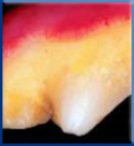
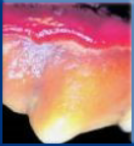
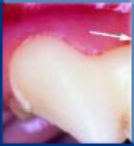
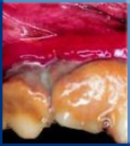
Stage 1
Gingivitis - redness at the gum-line, bad breath, mild tartar or discoloration of tooth enamel may be present
Stage 2
Advanced Gingivitis or Early Periodontitis - redness and swelling of the gums, plaque and tartar present above and below the gum-line
Stage 3
Moderate Periodontitis - moderate to severe plaque and tartar present, gums bleed with dental probing, swollen gums, loss of gum attachment to the tooth, pocket formation, slight tooth mobility may be present
Stage 4
Advanced Periodontitis - noticeable supporting bone loss, loose teeth, gum recession and deep pockets, severe plaque and tartar present, severe bad breath









































